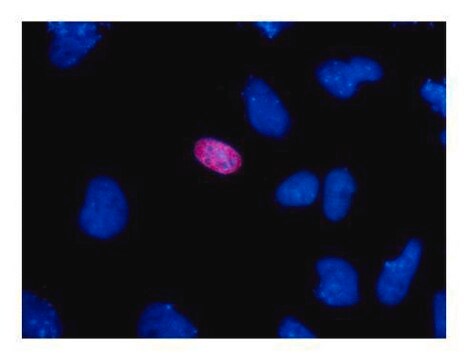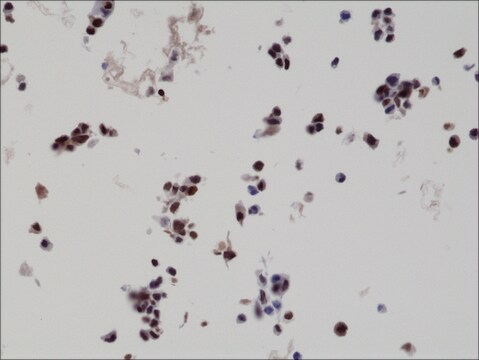04-902
Anti-HA Tag Antibody, clone DW2, rabbit monoclonal
culture supernatant, clone DW2, from rabbit
About This Item
Produits recommandés
Source biologique
rabbit
Niveau de qualité
Forme d'anticorps
culture supernatant
Type de produit anticorps
primary antibodies
Clone
DW2, monoclonal
Espèces réactives
vertebrates (common species)
Technique(s)
western blot: suitable
Isotype
IgG
Conditions d'expédition
dry ice
Modification post-traductionnelle de la cible
unmodified
Description générale
Spécificité
Immunogène
Application
Epitope Tags & General Use
Epitope Tags
Qualité
Lysates from non-transfected (lane 1) and HAtagged WNT-1 transfected (lane 2) HEK293 cells were resolved by electrophoresis, transferred to nitrocellulose and probed with anti-HA-Tag, clone DW2 (1:1,000 dilution).
Proteins were visualized using a goat anti-rabbit secondary antibody conjugated to HRP and a chemiluminescence detection system.
Arrow indicates the HA-tagged protein (~49 kDa). The apparent molecular weight is related to the tagged protein.
Description de la cible
Liaison
Forme physique
Stockage et stabilité
Remarque sur l'analyse
HA-tagged WNT-1 protein.
Clause de non-responsabilité
Vous ne trouvez pas le bon produit ?
Essayez notre Outil de sélection de produits.
Code de la classe de stockage
12 - Non Combustible Liquids
Classe de danger pour l'eau (WGK)
WGK 1
Point d'éclair (°F)
Not applicable
Point d'éclair (°C)
Not applicable
Certificats d'analyse (COA)
Recherchez un Certificats d'analyse (COA) en saisissant le numéro de lot du produit. Les numéros de lot figurent sur l'étiquette du produit après les mots "Lot" ou "Batch".
Déjà en possession de ce produit ?
Retrouvez la documentation relative aux produits que vous avez récemment achetés dans la Bibliothèque de documents.
Les clients ont également consulté
Notre équipe de scientifiques dispose d'une expérience dans tous les secteurs de la recherche, notamment en sciences de la vie, science des matériaux, synthèse chimique, chromatographie, analyse et dans de nombreux autres domaines..
Contacter notre Service technique








